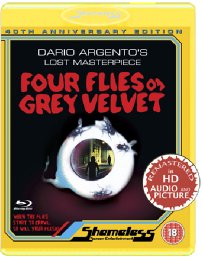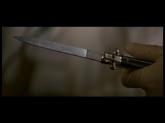Review for Four Flies On Grey Velvet
Four Flies on Grey Velvet
Dir: Dario Argento (1972)
Dario Argento needs no introduction for long-term genre fans. He has created some of horror cinemas' most shocking and vivid images over the past four decades or so, as well as several bonafide masterpieces. Unfortunately the second half of that period has seen the once cutting-edge director decline, to the point where his recent efforts have been amateurish in comparison. To the uninitiated, these represent a standard of cinema that is both unacceptable, and disturbingly, unwatchable.
In the Seventies though, Argento was a on a roll, patching together a string of hits that were artistically blistering, trailblazing pieces of film. Be it the Giallo shaping format evident in Bird with the Crystal Plumage (1969), the masterful cruelty of Deep Red (1975) or the sheer terror of Suspiria(1977), he manufactured a cannon that alone would ensure he attained a mythical status.
For those less invested in the horror genre, his violent, sometimes abstract, and increasingly redundant excursions are an alienating experience almost regardless of their achievements. Like many horror works to come out of Italy, the dubbing is often otherworldly, while the dialogue itself can frequently dissatisfy with a poor level of realism. Even the aesthetics that please the majority of genre fans- the framed, prolonged murder scenes that interrupt many Giallo and provide a moment that feels like staring at a painting, are intrinsic to the story, and indeed- the whole point of these films. But for detractors, they'll always appear unrealistic and unconvincing. Four Flies on Grey Velvet as an early, somewhat unseen Argento, has all of these issues to contend with, but at the same time, exhibits all of his early artistic ambition and creativity.
The plot is a typically red-herring laden piece of Giallo hokum. Roberto Tobias (as played by Michael Brandon), is a rather bland, if sociable drummer from a rock band. Seemingly, he's enduring a period of being stalked, by a man in black who follows him during rehearsal nights from the shadows. Deciding to confront this worrying predicament, Roberto inadvertently makes it worse, when he chases him into an abandoned theatre, and accidentally causes his death. From above, a second figure takes photos of the event, and Roberto realises he has been recorded stabbing the victim, and flees the scene. From this point, our unfortunate musical prodigy falls victim to a series of break-ins at his house, which each see the mystery figure leaving photos and evidence of Roberto's crime. Terrified for himself and his wife (Mimsy Farmer), he begins gathering help in solving the mystery, as dead bodies begin to pile up.
Obviously there are flaws in abundance here. Aside from the usual limited range exhibited by many of the stock characters, and some hideous dialogue, here's a degree of science involved in the eventual deduction process that's pretty barmy, and the characters behave in that traditional genre manner of making illogical decisions and continually sealing their own fate. In fact, much of the cast is quite weak, and the characters are rather poorly drawn, even by Argento standards.
Even less believable, is the now-trademark degree of investigation perpetrated by a member of the public. The central character goes about the police work with little consequence to the real world, and his crime/predicament appears to occur within some sort of abstract bubble in society. At least here, there's a context and a reason for the lead's wacky decision-making and general weirdness, whereas in Argento's recent failure, Giallo (2009), Adrian Brody was a bumbling, inept cop who stumbled upon clues rather than deducing them, Or in Bird With the Crystal Plumage, during which the detective sat back and let the protagonist do much of the work, simply because he was established as the main character. A further issue with our protagonist here, is that he's basically unsympathetic. Neither heroic or particularly pleasant, he eventually bonks his missus' cousin, in a development both unnecessary and unpleasant. In saying that, it does provide a slice of funky Euro-sleaze that's both eye-catching and amusing.
The problem with the lead is also the issue that Michael Brandon is not particularly engaging in the role. He's nowhere near as strong as the tremendous Tony Musante in "Bird", or David Hemmings in Deep Red. Roberto comes across as if he's some sort of David Bowie rip-off who has accidentally landed in the horror genre with a reluctant ambivalence, but the bigger problem is that so does everyone else. He looks ill at ease in a fairly lively social scene, in which he generally feels like a bit of a prat. Perhaps the issue is that the players are two-dimensionally slotted in place. If Brandon's character is truly an isolated, detached misfit, which he sometimes gives the impression, it isn't something in the fabric of his character, but rather an unfortunate side-effect of his flimsy conception.
Elsewhere, Ennio Morricone produces a jarring, sub-hippy score that has been much criticised. It probably deserves such condemnation, it's an oddity that doesn't really add to the thrills or tension. However, in terms of nostalgia, it certainly helps place the film purely in the Seventies, and fits alongside the lead character's bizarre, inappropriate personality.
Where Four Flies really succeeds though, is in the technical ingenuity. At times, Argento's camera is genuinely audacious. This is no more in evidence than in the flamboyant scene in which Dario's camera follows a phone line underground, and traces back to the killers liar. Like a similar moment in Tenebrae, it is something of a motif, and as a piece of bravado in 1972, really quite extraordinary. There's also an instance whereby Argento chooses to utilise an angle that follows the trail of a bullet, in a gimmick that has been much intimated since. Here, it's excessive, but still thrilling.
The film is also book ended by two enormously memorable moments. The first occurs right at the opening, as we're led into the film with a band's performance ,that concludes with the squishing of a fly in a drum cymbal. It is fabulous moment, and probably the best musical instance in the film, providing a neat, even groovy opening coda.
The climax of the film is terrific stuff, and certainly ranks among Argento's most jaw-dropping. Without spoiling the plot, it involves a car accident, and subsequently an little incident of improvised body-part removal that is both shocking and technically impressive. It's over the top certainly, but suitably so, and it's also hugely entertaining. An appropriate climax then, to a brash, uneven, but never less than fascinating film.
Shameless have, as per usual, done justice to their acquisition with a damn fine release to accompany such a scarcely seen picture. This Fortieth Anniversary Edition boasts an excellent HD remastering of the image that stands proudly alongside other great restoration jobs from the period. I can't imagine this film looking any better. It also sounds great, with Italian (complete with English subtitles), or English audio tracks, the latter being very impressive indeed.
An important feature is the inclusion of four inserts, or "the lost forty seconds", which can viewed either with the film, or as a separate addition. Again, this is nice, and significant inclusion for Argento aficionados.
A forty-plus minute interview with Luigi Cozzi is tremendous stuff though, and almost as entertaining as the film itself. He recalls the finest scenes, and the performances with great affection, but also provides some really intriguing insight about the process. A famously similar scene to one in the film, The Strange Vice of Mrs. Wardh (1971) is discussed, and comparisons drawn with a literary giallo which both scenes where clearly inspired by. In all, this is a really intriguing bonus feature.
Elsewhere, the disc also contains the usual Shameless lot- photo galleries and trailers for other Shameless releases. We do get both English and Italian trailers for Four Flies itself, with the fab Italian version definitely being worth a look.
In all, it's not exhaustive, but an impressive release nonetheless.
Four Flies is not the complete Giallo that Argento would go on to accomplish with Deep Red, nor does it have the hyper violence evident in later entries such as Tenebrae and Opera (1987). Some would also suggest that it is not quite of the same standard represented in the first two of the unofficial trilogy. It's true that Four Flies represents a sort of Argento time capsule, a rather groovy piece that sits alongside films such as Mario Bava's "Four Times That Night" from the same year, as not an entirely convincing tale, but a completely bizarre piece of swinging Seventies schlock that cannot fail to entertain. What it also does possess in abundance, is the skills of a young filmmaker approaching his prime, and absolutely oozing with bravado and thrilling ideas. This really isn't merely a film for Argento fanatics, it's of value to anyone intrigued by any period in Euro-horror, specifically Giallo, and for widely, anyone concerned with the evolution of horror film in the Seventies.

































Your Opinions and Comments
Be the first to post a comment!